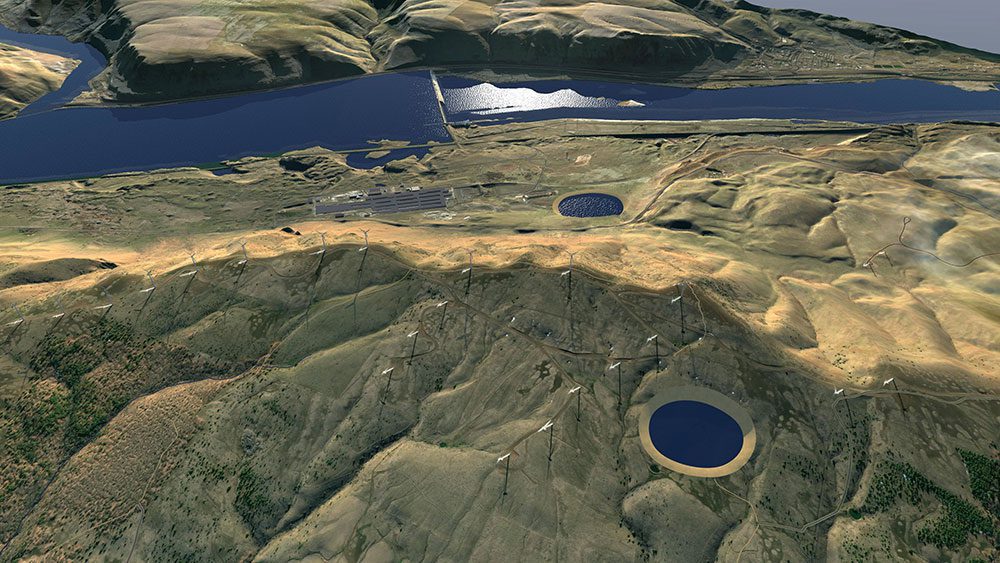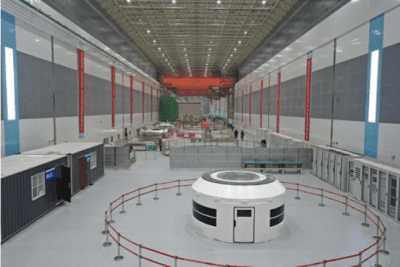Former Coal Mine Will House New Pumped-Hydro Storage Project

A company active in the hydropower sector is working on a new project to build a pumped-hydro storage facility at the site of a former coal mine in Kentucky.
Boston, Massachusetts-based Rye Development, which has a current in-design or operational portfolio of 25 projects in 10 states, on Jan. 4 announced it was developing the 200-MW Lewis Ridge Closed Loop Pumped Hydropower Storage project in Bell County. The company has filed for a permit for the project with the Federal Energy Regulatory Commission (FERC).
Michael Rooney, vice president of Project Management for Rye Development, told POWER on Jan. 5 that Rye expects the FERC application process will take a few years, while providing at least three-to-five-year construction process that would bring Lewis Ridge online by 2030.
This is the first project we are pursuing on a former coal site," said Rooney, who said it could be a model for future sites that could reclaim abandoned coal mines. Rye recognizes the opportunity that certain brownfield sites offer for closed-loop pumped storage projects. Oftentimes these sites have characteristics that are beneficial for large power generation or storage applications such as existing transmission access, favorable zoning, etc."
The project site has what Rye said is beneficial topography," along with proximity to transmission infrastructure.
Slow Growth in U.S., Rapid Pace in ChinaThe U.S. Dept. of Energy (DOE) has said pumped storage facilities are the most common form of energy storage in the U.S., representing 95% of all utility-scale storage. Most U.S. pumped storage facilities were built between 1960 and 1990, according to the U.S. Energy Information Administration (EIA). The agency has said about 21 GW of pumped storage is in use today. The group said that while FERC has approved a handful of new pumped storage projects since 2014, the U.S has not added any new pumped storage capacity since 2012-with just two new plants coming online since 2000.
 Chinese officials have announced the 3.6-GW Fengning pumped-hydro storage project, shown in this rendering, is now online. Source: State Grid Corp. of China
Chinese officials have announced the 3.6-GW Fengning pumped-hydro storage project, shown in this rendering, is now online. Source: State Grid Corp. of ChinaThe technology is advancing more rapidly elsewhere. Chinese officials this week announced they have commissioned what they called the largest pumped-hydro storage facility in the world. The State Grid Corp. of China, the state-owned and largest power utility in China, said a 3.6-GW system-the $1.9 billion Fengning Pumped Storage Power Station-is now operating in the Hebei province. The International Renewable Energy Agency recently said China, which has just more than 30 GW of pumped-hydro storage operating today, plans to have 62 GW of pumped-hydro storage online by 2025, nearly doubling to 120 GW by 2030.
China also is among the countries looking at developing pumped-hydro storage sited at former coal mines. Officials have been studying whether coal mine goafs-a goaf is a part of the mine where the coal has been worked away, leaving a cavernous area or expanse that could be used as an underground reservoir-could support pumped-hydro storage installations.
Renewed U.S. SupportPumped-hydro storage in the U.S. is receiving renewed support from the DOE and Congress, spurring more research and development into hydropower in general along with pumped storage. The DOE in September 2021 announced a new $8.5 million funding opportunity to improve the operational flexibility of the U.S. hydropower fleet, with the DOE's Water Power Technologies Office (WPTO) funding up to six awards to advance hydropower technologies to enhance power grid reliability. The awards will support the WPTO's HydroWIRES Initiative, which seeks to understand, enable, and improve hydropower and pumped storage hydropower's contributions to reliability, resilience, and integration in the rapidly evolving U.S. electricity system," according to the DOE.
The Lewis Ridge installation is sited along the Cumberland River near four Kentucky communities that have long depended on coal mining. The towns of Callaway, Balkan, Blackmont, and Tejay are among several in Bell County that have supported mining operations for more than a century, according to Kentucky Coal Heritage.
Rye in its announcement said the Lewis Ridge project will bring nearly $1 billion to Bell County along with 2,000 construction jobs over a three- to five-year build period. It also would provide several dozen direct and indirect" jobs once the project is operational later this decade. The project is expected to have a 50-year operating license after FERC's approval.
Rye is proud to bring these types of developments to coal communities in the U.S.-delivering on the promise of jobs in the energy transition," said Paul Jacob, CEO of Rye. The Lewis Ridge project marks a significant step forward in the push toward a more renewable energy grid."
Closed-Loop SystemLewis Ridge, like other closed-loop pumped storage facilities, will feature a system that moves water between a manmade lower reservoir and a manmade upper reservoir. Water is released from the upper reservoir, and used to turn hydroelectric turbines to generate electricity. The water is than collected in the lower reservoir, and returned to the upper reservoir to repeat the process, in effect recycling the same water over and over to produce power.
Rye officials said pumped storage offers a flexible solution to the changing grid, including the ability to store intermittent solar and wind resources moving forward."
Rye is the leading developer of this type of long-duration storage in the U.S.," said Rooney, noting the company's expertise in the hydropower sector. As an example, Rye's Swan Lake project is a late-stage project that will be the first closed-loop pumped storage facility built in the country when it comes online in 2026." The 400-MW Swan Lake installation, sited in southern Oregon, also is designed to support renewable energy power generation.
 The Goldendale pumped-hydro storage facility would be located in Washington state. Rye Development officials have said Goldendale will be a 1.2-GW, $2 billion-plus installation that could come online by 2028. Courtesy: Rye Development
The Goldendale pumped-hydro storage facility would be located in Washington state. Rye Development officials have said Goldendale will be a 1.2-GW, $2 billion-plus installation that could come online by 2028. Courtesy: Rye DevelopmentRye also is developing the 1.2-GW Goldendale pumped storage project in Washington state. Rooney told POWER, Rye has submitted its full application to FERC for the project and expects a decision on full license in 2023." Construction would begin in 2025, with commercial operation expected in 2028. Both the Swan Lake and Goldendale projects were purchased in late 2020 by Copenhagen Infrastructure Partners, with Rye continuing to lead development of the sites.
The Goldendale project is described as a $2 billion-plus closed-loop facility. It would be located on the Oregon-Washington border, about eight miles southeast of Goldendale, Washington. The project, like Rye's other installations, is designed to help balance the local power grid with an ability to store excess solar and wind power. Goldendale is one of two projects selected by the HydroWIRES program in 2018 to serve as case studies for the DOE's Pumped Storage Valuation Guidebook." The other is Banner Mountain PSH in Wyoming, a project led by Montana-based Absaroka Energy.
-Darrell Proctor is a senior associate editor for POWER (@POWERmagazine).
The post Former Coal Mine Will House New Pumped-Hydro Storage Project appeared first on POWER Magazine.